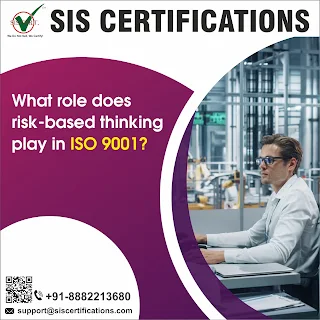What role does risk-based thinking play in ISO 9001?
Risk-based thinking is a key concept in the ISO 9001:2015 standard, which is the international standard for quality management systems (QMS). ISO 9001:2015 emphasizes a proactive approach to quality management, and risk-based thinking is a fundamental aspect of this approach. The integration of risk-based thinking reflects the recognition that uncertainties and risks are inherent in any business or organizational context.
Here are some key points regarding the role of risk-based
thinking in ISO 9001:
Context of the
Organization:
ISO 9001:2015
requires organizations to determine the external and internal issues that can
affect their ability to achieve the intended outcomes of their QMS. This
includes identifying risks and opportunities associated with these issues.
Leadership
Involvement:
Top management is responsible for ensuring that risk-based
thinking is integrated into the organization's QMS. This involves setting the
direction for the organization, establishing policies related to risk
management, and ensuring that risk is considered in decision-making processes.
Planning:
During the planning phase, organizations are required to
identify risks and opportunities that could affect the QMS and its ability to
deliver conforming products and services. This includes considering both
positive and negative aspects.
Integration with
Processes:
Risk-based thinking is integrated into various processes
within the QMS. For example, during the planning of changes, organizations need
to assess the potential impact on their ability to achieve the intended
outcomes and address any associated risks.
Performance
Evaluation:
Organizations are required to monitor, measure, analyze, and
evaluate the performance of their QMS. This includes assessing the
effectiveness of actions taken to address risks and opportunities.
Continuous
Improvement:
The concept of risk-based thinking supports the continuous
improvement of the QMS. Organizations are encouraged to learn from experience,
both positive and negative, and use this knowledge to improve their processes
and overall performance.
In summary, risk-based thinking in ISO 9001:2015 is a
proactive and systematic approach to identifying, assessing, and addressing
risks and opportunities that can impact the achievement of quality objectives.
By integrating risk management into various aspects of the QMS, organizations
are better equipped to navigate uncertainties and enhance their ability to
consistently deliver quality products and services.



Comments
Post a Comment